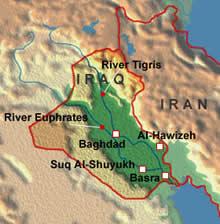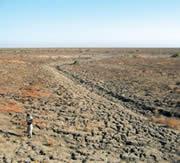Iraq's marshlands, ravaged during Saddam Hussein's regime, show signs of bouncing back, say scientists who have surveyed the region's ecosystems. They are hopeful that some 30% of the former marshland, which was reduced to desert during the 1980s and 1990s, can be restored.
The marshlands, thought by some to be the scene of the biblical Garden of Eden, once covered some 15,000 square kilometres. But they were drained by the Iraqi government, partly to punish local Marsh Arab communities for political uprisings.
At the time of Saddam's overthrow in 2003, roughly 10% of the original marshes remained, says Curtis Richardson of Duke University in Durham, North Carolina, who carried out the recent survey along with US and Iraqi colleagues. The significance of the destruction has been likened to that of deforestation in the Amazon basin.
 Large swathes of former marshlands in Southern Iraq have dried up.© news@nature.com
Large swathes of former marshlands in Southern Iraq have dried up.© news@nature.comRestoring the marshes isn't necessarily straightforward. When the marshes dried up, the soil was left in an extremely salty state. So one hazard of reflooding the land is that, if fresh water is not kept flowing continuously, the water will become too salty for the area's natural species to survive.
Some marshland has already been partially flooded by local people, who tore down dams in a bid to get water back on to their land. That has given Richardson's team the chance to investigate how the region might fare in a more carefully planned restoration. Last year, the United Nations Environment Programme pledged US$11 million for such a scheme.
Opening floodgates
The researchers set up monitoring stations in two reflooded areas, and compared them with the natural remaining marshland at Al-Hawizeh, on the Iranian border. They measured water quality, and surveyed the plant and animal life present.
The restored marshes do show signs of recovery, Richardson told the annual meeting of the American Association for the Advancement of Science in Washington DC on 19 February. But the untouched marshland was still considerably healthier.
Salt levels in the reflooded marsh at Suq al-Shuyukh were higher than at Al-Hawizeh, say the researchers, who also publish their findings in Science1. However, water quality at the other reflooded site, Abu Zarag, was similar to that in the pristine marsh.
Typical plant species, dominated by the reed Phragmites australis, are also returning to the two restored marshes, the researchers report. But the colonization by plants and animals has not yet reached the levels at Al-Hawizeh. This site, for example, is still the only home of the otters that once roamed the entire region.
Restoring populations
 Cracked marsh soil lines a dried-out streambed in the totally drained Central marsh near Chibayish.© C.J. Richardson
Cracked marsh soil lines a dried-out streambed in the totally drained Central marsh near Chibayish.© C.J. RichardsonRichardson and his team hope that some 30% of the original area can be restored. "It's down to how much water you can get in," Richardson told the meeting. "We're hoping to restore large blocks, but it won't be contiguous marshland as before."
The process will depend partly on water conflicts with Iraq's neighbours. Iran is planning to build a large dyke, which would prevent the River Tigris from watering Al-Hawizeh. And Turkey's Ataturk Dam is large enough to slow the River Euphrates to a trickle.
But if the Garden of Eden can be saved, it could be a huge boost for the region's Shia population, which fell from 350,000 in a 1947 census to around 75,000 today. The 12 major tribes of Marsh Arabs moved away during the 1990s as their homelands dried up, said Peter Reiss, a water resources expert with the US Agency for International Development.
Restoring the marshlands could entice them to return, he says. "They don't want to be made museum specimens, they want clean water. If they can have a stable life there they will go back."
